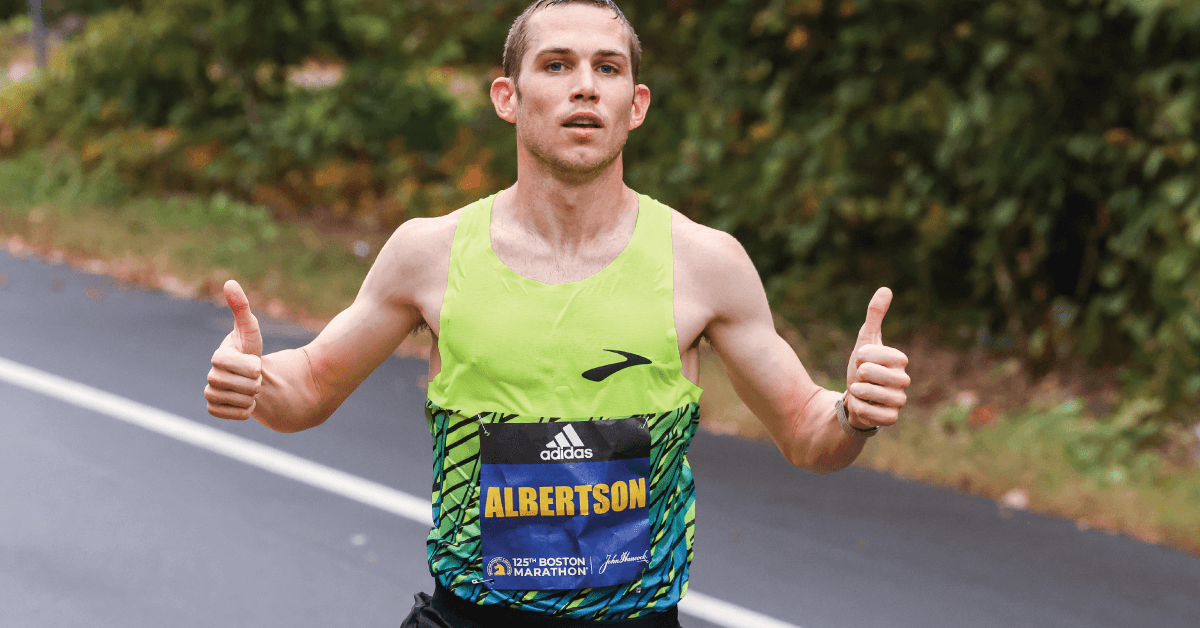CJ Albertson's Training Tips for the Marathon


I led the the first 21 miles of the 2021 Boston Marathon. This strategy was simply a result of running this fabled course in a way that best suited my strengths. The first half of Boston is mostly downhill, and I’m great at downhills. In addition, I’m good at starting at a decent pace and then maintaining that speed or just slightly slowing down- rather than having a big negative split. So those two factors almost guarantee my first half marathon (in Boston specifically) will be faster than my 2nd half. With that in mind, I ran a pace that felt comfortable for me and just so happened to put me in the lead.
There are several key points any runner can learn from this:
Key point #1: Run your own race
As cliche as it sounds, you have to run your own race. Find the specific pacing strategies, nutrition choices, and tapering strategies that work for you.
Key point #2: Be flexible
I didn’t expect to lead, but it helped that I didn’t freak out once I was in the lead. If things don’t go how you plan, you may need to make an adjustment, but for the most part just stay calm and relaxed.
Key point #3: Enjoy the moment
Being in the lead made the race a lot of fun and I certainly soaked in the experience. But all runners can do the same. You will run your best when you’re fully immersed in the race and enjoying the experience. Dwelling on how bad you feel or how you hate the headwind isn’t going to help.
Tips for your marathon prep:
Tip #1: Run (a lot)
There’s no magic mileage number, but for a marathon, you simply have to run a lot. Cross training, such as cycling, is great for beginners and can be incredibly helpful for your first few 5ks and 10ks. But for a marathon, your body has to handle the pounding on the pavement for hours. Strength training can help with this, but you need to run. Most people can run more than they think they can without being injured. The key is consistency. I’ve coached very few people who have gotten injured after completing all their runs and by adding just a few miles a week. If you miss runs, add mileage too fast, add in lots of speed work or hills all of the sudden, then most likely, you’ll be injured. But the mileage itself (or long runs) usually isn’t the problem. Just build into it.
Tip #2: Fine-tune your Fueling
To truly run a marathon as fast as possible, you need some additional carbs throughout the race. Most people will achieve adequate carbohydrates by consuming up to 60g of carbs per hour. This equates to roughly a gel every 3-4 miles. If you practice this in training, fueling can become really simple.
Tip #3: What Goes Up Must Come Down
Downhills make you more sore than uphills. It’s just a fact. When you include hill repeats, also include downhills such as downhill hill strides- especially when training for Boston. This will help to prepare your body for both the uphill and downhill demands of the race.
Tip #4: Do Your Long Runs Fast (sometimes)
Many beginners run their easy runs too fast and start out too quickly on their long runs. However, this isn’t what I’m talking about. For experienced runners who have no issues running 20 miles at a conversational pace, it’s time to challenge yourself on your long runs. When training for a marathon, your long runs should be pretty hard- usually your hardest day of the week. Start to run many of your long run miles at around 15-30 seconds per mile slower than goal marathon pace. Towards the end of your run you can pick it up towards your goal pace. You can also do runs where you go 20ish miles alternating 1-2 miles at your goal marathon pace with the following mile about 45-55 seconds slower.
Tip #5: Enjoy your training
Some aspects of training, you simply have to get done. But for the most part, do what you like. Run routes you enjoy, do the ‘speed workouts’ that are fun for you, and don’t obsess about every little detail. The marathon is pretty simple. Run a lot. Run long and hard once every 7-14 days. Run fast around once a week, and do some strides and strength/form work every now and then. The actual specifics don’t matter as much, so just have fun with it so you’re more consistent.
Tip #6: Still Train When You Don’t Enjoy It (usually)
Training for an endurance event isn’t always easy or ‘fun’. Oftentimes, we get tired, sore, unmotivated, etc. This is a good thing- otherwise it’d mean our nervous system is a little messed up. When you are training, you have to expect you will have days when you simply don’t want to do it. Sometimes, it’s fine to back off or push a hard workout to the next day. But for the most part, you just have to get out the door. The more you get into a consistent rhythm of training, the easier it will become- but it will never be easy all the time. Having a friend, team, coach, etc. to keep you accountable can be very helpful. In addition, you’ll inevitably have days and weeks where you simply run slow. This doesn’t mean you’ve magically lost fitness. Just get a good meal (with carbs), mediadate or relax, and sleep. You’ll be fine.

